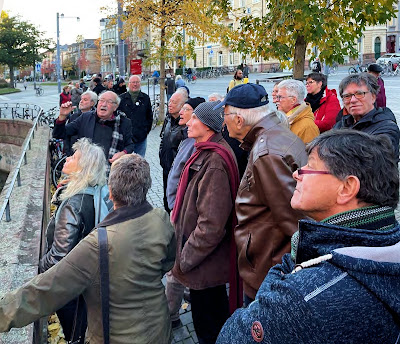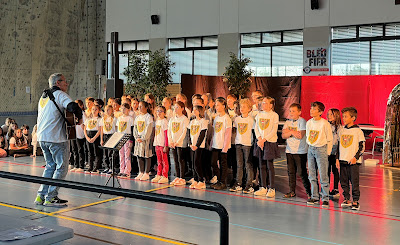Remember the Seminar early this year titled:
My friend Thomas made me aware of the seminar, and he and I attended. As a
result, I wrote a few blogs (Click on the numbers
1,
2,
3,
4,
5 ).
The discussions were not over for Thomas, so he proposed an
institute discussion as a follow-up. The topic he formulated was:
The Beginninglessness of the Universe and the Theological Consequences
The discussion took place on December 19 in a small circle at the
Theological Institute of Freiburg's university, comprising the theology
professors of the seminar. The conversations were animated by wine and Christmas
goodies. The physics professor could not attend, so experimental physicist Red
Baron had to stand in for questions of modern cosmology.
In the
run-up to the event, Prof.
Magnus Striet
had put forward eight theses with the title:
Creation Out Of Nothing Or an Eternal World?
1)
From the point of view of scientific theory, theology is an integrative
science. This means that knowledge complexes from non-theological sciences
must be incorporated into theological thinking about the world. Theology interprets them under the hypothetical assumption of God.2)
The concept of God must
a) be defined,
b) it must be possible to
think it consistently in relation to world knowledge and
c) it must not
collide with the (transcendental-logical) fact of human freedom.
3)
From a historical point of view, the concept of creation out of nothing
emerged in the emerging Christianity because one wanted to think of God's
historical power, which in turn presupposes freedom on the part of God.
This cannot be conceived under the presuppositions of Greek philosophy.
At the same time, one wants God to think of an absolute, which is not given if
matter or the world are eternal.
Neither the concept of nothingness nor that
of eternity can be positively defined.4)
The practical needs of reason (which can be traced back to contemporary
philosophy) allow us to hold on to the concept of a free God.6)
Identifying the cosmic process with the "divine" and abandoning the
distinction between God, the world, and man is contrary to the needs of
practical moral reason.
7)
Philosophically, the question of whether the world (the quantum vacuum) is
eternal or not cannot be decided. Nor can the existence of a free God be
sufficiently proven.8)
Theologically, the existence of a free God is posited. In this
perspective, the fact of the world is anchored in a reason that is this God
without being able to conclusively clarify the relationship between the free
God and the beginning of the cosmic process.
Freiburg, 18.12.2024
Red Baron received a copy of these theses, which included additional information
(printed in red). Here, I would like to come in (the original text
is in italics).
In a physical sense, the quantum vacuum preceding the Big Bang is not
nothing. In a scientific way of thinking, it can no longer be asked whether
this vacuum has a non-physical reason.At the end of the paragraph, the author writes,
We cannot say anything about the nature of the world before/beyond the Big
Bang. Red Baron would underline this, although theoretical colleagues have
speculated about a quantum vacuum before the Big Bang and accordingly made
model calculations.
Taking up the argumentation,
The vacuum of quantum mechanics is the energetic ground state of a (bound)
physical system. It is directly linked to the existence of space (or an
associated measurand)."
Indeed, the present standard Lamda Cold Dark Matter (ΛCDM)
model of cosmology describes the beginning of our space-time and makes no
statement about what was before the Big Bang.
This present-day
knowledge contrasts the beginninglessness of the universe, meaning that it has
no beginning in time. However, there are several theories to it, just to name
a few:
1. The universe is eternal. It has no beginning and has
always existed in some form.
2. The universe bounces through cycles of
Big Bangs (expansion) and Big Crashes (contraction), with no definitive
beginning.
3. The universe could have originated from quantum
fluctuations ex nihilo, which does not require a precise beginning time.
However,
with all those theories, there is a
caveat: These studies rely on
mathematical models that cannot be directly verified by current observational
technologies. The theoretical findings assume specific conditions that remain
hypothetical.
On the other hand, experiments have repeatedly
confirmed Einstein's General Theory of Relativity. However, dark matter had to be introduced
into the standard ΛCDM model to fully align with cosmological observations.
Other descriptions of the
universe exist, like the MODified Newtonian Dynamics theory, or MOND for short. This
model eliminates the ugly dark matter assumption.
Recently, astrophysical results obtained from the James Webb Space
Telescope supported MOND. Astrophysicists observed large, bright galaxies in the early universe instead of the small, simple ones predicted by the ΛCDM model. These
observations impressively fit the MOND theory.
In conclusion, the
authors write in their paper:
A number of puzzling observations in cosmology were anticipated by MOND,
including the early formation of massive galaxies.
Despite the
predictive successes of MOND, we do not yet know how to construct a
cosmology based on it. In contrast, ΛCDM provides a good fit to a wide range
of cosmological observables but does not satisfactorily explain the many
phenomena that were predicted by MOND.
We find ourselves caught between two very different theories that seem
irreconcilable despite applying to closely related yet incommensurate
lines of evidence. The simple force law hypothesized by MOND has made
enough successful prior predictions that it cannot be an accident; it must
be telling us something.
And then the authors can't resist a side blow:
What that is remains as mysterious as the composition of dark matter. Red Baron's initial religious education was based on Bible
stories. However, as a young student, I realized I had to take up the subject again as an adult and deepen it.
A great help
was my father-in-law, a teacher at the Catholic Apostel Gymnasium (high
school) in Cologne, who introduced me to
Rudolf Bultmann,
Edward Schillebecckx,
Karl Rahner, and
Joseph Ratzinger. With Toni, I had long discussions. Later,
Hans Küng
was my favorite reading. Despite all my efforts, I never found proof of the
existence of God.
That is why verse 13 of St. Paul's letter to the Corinthians has always
been my maxim,
So now faith, hope, and love abide, these three; but the greatest of these
is love. This verse is preceded by For now, we know, in part,
regarding theologians, philosophers, and physicists alike.
As for verse 13, let me put hope above love for once in the
coming year. Hope for a lasting peace in our world.
*

















































